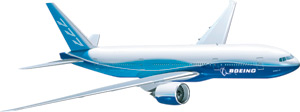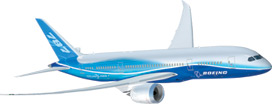
TRAINING TECHNOLOGY INSPIRED BY THE AIRPLANE
The new 787 training system reflects many of the advanced technologies in the 787 Dreamliner itself. This approach puts the trainee — whether in flight training or maintenance training — as close to the actual airplane as possible. The effectiveness of this approach means shorter, more efficient training footprints. For example, a 777 pilot can complete 787 flight differences training in five days with no full-flight simulator, and the maintenance training Line and Base Course is 50 percent shorter than the 777 course. Distance learning options reduce time at the training center and prepare students for formal training.
Simulation-based training. One of the objectives of the new training system is to replicate the airplane — not just the flight deck — and bring real, performance-based information to pilots and mechanics. This led to the use of real-time simulation in the maintenance training environment that allows practice on the same tools in the classroom that the mechanics actually use in the field on the airplane.
It also inspired the use of flat panel, touch-screen trainers that have simulated functionality, as well as real hardware where tactile feel is important. These simulators can be used to train pilots on all aspects of operation, including the new heads-up display and electronic flight bag features of the 787 without the need for costly fixed-base simulators.
E-enabled and digital technology. Technological advances in the airplane inspired similar technological advances in training. For instance, the airplane is e-enabled and so is training, including training delivered just in time at the point of use. The development work in progress targets a Web-managed, distance-learning capability that brings training to the trainee in a paperless training environment. Enhanced technical data for flight training will include linkable features in the Flight Crew Operating Manual and Flight Crew Training Manual. The system also provides training that familiarizes mechanics with the 787's real-time, current airplane performance support data that is accessed through the Web portal MyBoeingFleet.com.
Respect for the environment. An e-enabled airplane supports a more environmentally progressive training solution. Distance learning enables more training to be conducted locally. Digital Web-managed training, training support products, and the use of tablet personal computers for note-taking eliminate the need for paper along with the attendant production waste, transportation, distribution, storage, and revisions.
FLIGHT TRAINING
The philosophy behind the 787 flight training program is to leverage airplane commonality with the 777 and other Boeing models, enable students to achieve a high degree of proficiency, and continue to build on the success of the Shortened Transition and Rating (STAR) courses. The STAR courses reduce the transition time for pilots current on other Boeing models by eliminating tasks and objectives that are common between those models and the 787. In keeping with the concept of training technology inspired by the airplane itself, 787 flight training incorporates modern simulation tools, Web-managed academics, and performance support data to provide an effective training environment that mirrors the actual airplane. Training is available through Alteon, Boeing's training subsidiary, at a global network of 787 training centers.
Commonality. The 787 is designed to be operationally common with the existing Boeing fleet, with the highest commonality with the 777 (see fig. 1). For instance, even though it may look different, the 787 flight deck operates just like the flight deck on a 777. As a result, it takes as few as five days of training for 777 pilots to qualify as 787 pilots. The pilot pool for operators of 777/787 mixed fleets is the same, and 787 pilots will spend less time training and more time flying.
The commonality extends to other Boeing airplanes as well. For example, Boeing is developing other short courses, such as a course from the 767 to 787, which could be as short as eight days. (As a comparison, it would take more than 21 days to train these pilots to fly a non-Boeing airplane.)
HIGH DEGREE OF PROCEDURAL COMMONALITY BETWEEN 777 AND 787
Figure 1
The high degree of commonality between the 777 and 787 means it will take as few as five days of training for 777 pilots to qualify as 787 pilots.
 |
||||
| Similar ETOPS
Cruise speeds compatible: 787 ECON cruise M 0.85 |
 |
Nearly identical flight maneuvers
Same flight deck operational and design philosophy |
 |
Same takeoff and landing technique
Same autoland and non-precision approaches Common normal and non-normal procedures |
 |
||||

